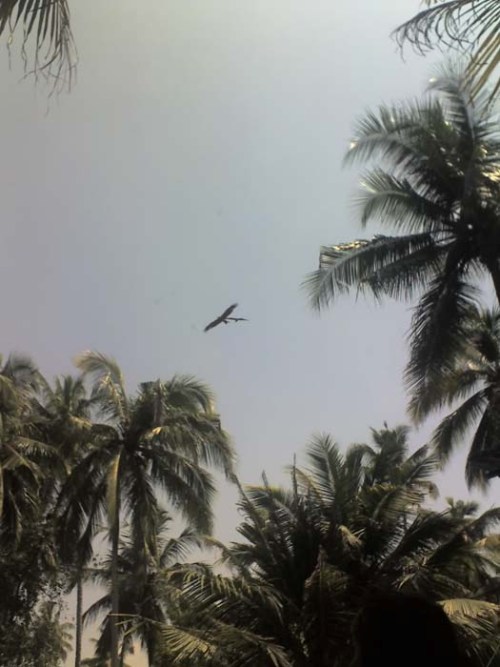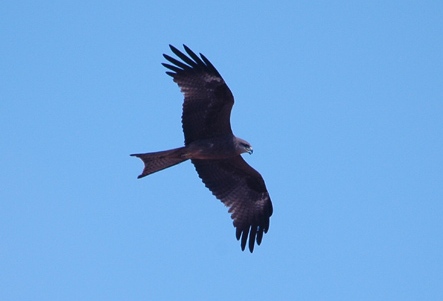Update: Kerala Thunderbird Photo
Posted by: Loren Coleman on May 14th, 2007
This photographic update and comparison on the recent “New Thunderbird Photos” posting shows a possible species that may or may not explain the Indian example.
You be the judge.

Regarding the “Thunderbird” photograph (above) taken in Kerala, India, French cryptozoology student Fabrice Tortey suggests that although “size evaluation in the sky without point of reference is rather tricky, I think the birds are probably black kites (Milvus migrans govinda). The shape of the tail is characteristic.” See two photos of this species below.


I’m not certain how much can be seen of the tail from the distance demonstrated by this photograph, but the straight top (anterior) edge of the wings does not seem to indicate the pointed characteristics of the typical black kite’s wings. It does seem like the straighter “barn door” profile of the vultures.
What do you see?
About Loren Coleman
Loren Coleman is one of the world’s leading cryptozoologists, some say “the” leading living cryptozoologist. Certainly, he is acknowledged as the current living American researcher and writer who has most popularized cryptozoology in the late 20th and early 21st centuries.
Starting his fieldwork and investigations in 1960, after traveling and trekking extensively in pursuit of cryptozoological mysteries, Coleman began writing to share his experiences in 1969. An honorary member of Ivan T. Sanderson’s Society for the Investigation of the Unexplained in the 1970s, Coleman has been bestowed with similar honorary memberships of the North Idaho College Cryptozoology Club in 1983, and in subsequent years, that of the British Columbia Scientific Cryptozoology Club, CryptoSafari International, and other international organizations. He was also a Life Member and Benefactor of the International Society of Cryptozoology (now-defunct).
Loren Coleman’s daily blog, as a member of the Cryptomundo Team, served as an ongoing avenue of communication for the ever-growing body of cryptozoo news from 2005 through 2013. He returned as an infrequent contributor beginning Halloween week of 2015.
Coleman is the founder in 2003, and current director of the International Cryptozoology Museum in Portland, Maine.










I don’t see a giant crypto-bird. If not a kite, then a average sized vulture.
Two anomalies on the Kerala thunderbird photo make the black kite explanation unlikely, IMHO.
Each wing has two knots (widening points) as opposed to one as is typical for birds of pray and other gliders.
Each wing seems to be 3X+ the length of the body as opposed to 2X for a black kite.
This link to European Raptor Photographs has many pictures of raptors in flight. Only the spanish imperial eagle has the 3X wing-to-body length ratio.
It’s funny, I was reflecting on someone’s comment on the original photo about the shape of the wings, when I happened to look up at a kite (they’re quite common here in the south of Japan, and I see several in a day). Sure enough it resembled the subjects in the photo and I was going to post something to that effect, but it seems that I was beaten by the clever person who did this comparison.
Just my two cents.
Not thinking we have Rodan here, but Richard888 thinks what I thought when I saw the kite photos: the kite doesn’t seem to have the requisite wingspan.
Then we have elsanto here, who sees them daily. If they look like what he’s seen, I may have to bow to experience.
Yup, my point exactly (last topic of this matter).
I really want to believe in Thunderbirds, but I just can’t be convinced. There is nothing in these photos that proves anything to me. I don’t see anything extraordinary about these pictures. When a Thunderbird poops on my windshield I may change my mind.
Again, the biggest problem with Th-Bird stuff is most of the time you are looking up into the sky where there are very few reference points and it’s hard to relay scale and hard for the eyes to realistically get an idea of just how big something is in the air…you would practically need a known plane, helicopter, kite, etc. in the frame (if you’re taking video or picture) or eyesight to get a conclusive idea of just how big something is…and even then the bird and other object would have to be relatively close to one another to get a reasonable idea of size…
in the end I guess I am saying…I have always been intrigued and fascinated on the Th-Bird front, but that is one arena that unless we get a REAL flawless shot, it’s going to almost impossible to pin something down.
Okay, that’s my two cents and a nickel…
ha ha it’s a very nice kite.
The birds do look close but I don’t think its the same bird or species, but the pic that’s thought of as a “Thunder Bird” has something near where its head should be, I’m thinking it’s either the bird’s head or it has something in its mouth. Most birds that I have seen try to carry their prey with their talons, sometimes you’ll see prey in their mouth but eventually they’ll land and try and drop it pick it up with the talons and carry it back to the nest, and if the object I see is it’s head well, thats a strange shape for a head. Then again, I’m no expert or anything, that’s what I see, and please tell me what you think even if it proves me to be wrong.
Look at it, if it is not a kite then it is a Thunderbird.
also look at its head, it does not look like a volture.